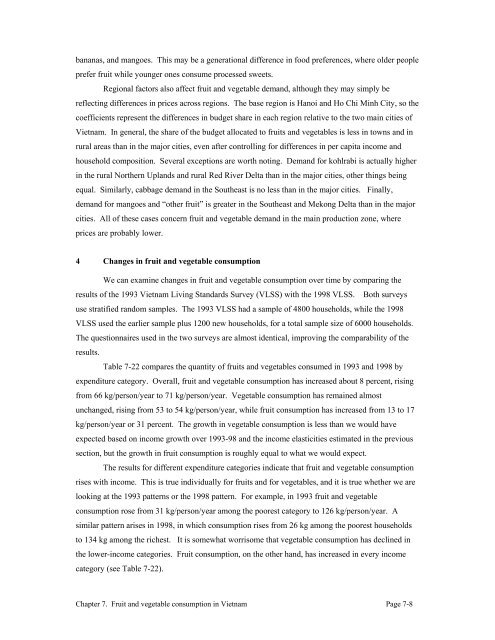Fruits and Vegetables in Vietnam - International Food Policy ...
Fruits and Vegetables in Vietnam - International Food Policy ...
Fruits and Vegetables in Vietnam - International Food Policy ...
Create successful ePaper yourself
Turn your PDF publications into a flip-book with our unique Google optimized e-Paper software.
ananas, <strong>and</strong> mangoes. This may be a generational difference <strong>in</strong> food preferences, where older people<br />
prefer fruit while younger ones consume processed sweets.<br />
Regional factors also affect fruit <strong>and</strong> vegetable dem<strong>and</strong>, although they may simply be<br />
reflect<strong>in</strong>g differences <strong>in</strong> prices across regions. The base region is Hanoi <strong>and</strong> Ho Chi M<strong>in</strong>h City, so the<br />
coefficients represent the differences <strong>in</strong> budget share <strong>in</strong> each region relative to the two ma<strong>in</strong> cities of<br />
<strong>Vietnam</strong>. In general, the share of the budget allocated to fruits <strong>and</strong> vegetables is less <strong>in</strong> towns <strong>and</strong> <strong>in</strong><br />
rural areas than <strong>in</strong> the major cities, even after controll<strong>in</strong>g for differences <strong>in</strong> per capita <strong>in</strong>come <strong>and</strong><br />
household composition. Several exceptions are worth not<strong>in</strong>g. Dem<strong>and</strong> for kohlrabi is actually higher<br />
<strong>in</strong> the rural Northern Upl<strong>and</strong>s <strong>and</strong> rural Red River Delta than <strong>in</strong> the major cities, other th<strong>in</strong>gs be<strong>in</strong>g<br />
equal. Similarly, cabbage dem<strong>and</strong> <strong>in</strong> the Southeast is no less than <strong>in</strong> the major cities. F<strong>in</strong>ally,<br />
dem<strong>and</strong> for mangoes <strong>and</strong> “other fruit” is greater <strong>in</strong> the Southeast <strong>and</strong> Mekong Delta than <strong>in</strong> the major<br />
cities. All of these cases concern fruit <strong>and</strong> vegetable dem<strong>and</strong> <strong>in</strong> the ma<strong>in</strong> production zone, where<br />
prices are probably lower.<br />
4 Changes <strong>in</strong> fruit <strong>and</strong> vegetable consumption<br />
We can exam<strong>in</strong>e changes <strong>in</strong> fruit <strong>and</strong> vegetable consumption over time by compar<strong>in</strong>g the<br />
results of the 1993 <strong>Vietnam</strong> Liv<strong>in</strong>g St<strong>and</strong>ards Survey (VLSS) with the 1998 VLSS. Both surveys<br />
use stratified r<strong>and</strong>om samples. The 1993 VLSS had a sample of 4800 households, while the 1998<br />
VLSS used the earlier sample plus 1200 new households, for a total sample size of 6000 households.<br />
The questionnaires used <strong>in</strong> the two surveys are almost identical, improv<strong>in</strong>g the comparability of the<br />
results.<br />
Table 7-22 compares the quantity of fruits <strong>and</strong> vegetables consumed <strong>in</strong> 1993 <strong>and</strong> 1998 by<br />
expenditure category. Overall, fruit <strong>and</strong> vegetable consumption has <strong>in</strong>creased about 8 percent, ris<strong>in</strong>g<br />
from 66 kg/person/year to 71 kg/person/year. Vegetable consumption has rema<strong>in</strong>ed almost<br />
unchanged, ris<strong>in</strong>g from 53 to 54 kg/person/year, while fruit consumption has <strong>in</strong>creased from 13 to 17<br />
kg/person/year or 31 percent. The growth <strong>in</strong> vegetable consumption is less than we would have<br />
expected based on <strong>in</strong>come growth over 1993-98 <strong>and</strong> the <strong>in</strong>come elasticities estimated <strong>in</strong> the previous<br />
section, but the growth <strong>in</strong> fruit consumption is roughly equal to what we would expect.<br />
The results for different expenditure categories <strong>in</strong>dicate that fruit <strong>and</strong> vegetable consumption<br />
rises with <strong>in</strong>come. This is true <strong>in</strong>dividually for fruits <strong>and</strong> for vegetables, <strong>and</strong> it is true whether we are<br />
look<strong>in</strong>g at the 1993 patterns or the 1998 pattern. For example, <strong>in</strong> 1993 fruit <strong>and</strong> vegetable<br />
consumption rose from 31 kg/person/year among the poorest category to 126 kg/person/year. A<br />
similar pattern arises <strong>in</strong> 1998, <strong>in</strong> which consumption rises from 26 kg among the poorest households<br />
to 134 kg among the richest. It is somewhat worrisome that vegetable consumption has decl<strong>in</strong>ed <strong>in</strong><br />
the lower-<strong>in</strong>come categories. Fruit consumption, on the other h<strong>and</strong>, has <strong>in</strong>creased <strong>in</strong> every <strong>in</strong>come<br />
category (see Table 7-22).<br />
Chapter 7. Fruit <strong>and</strong> vegetable consumption <strong>in</strong> <strong>Vietnam</strong> Page 7-8
















